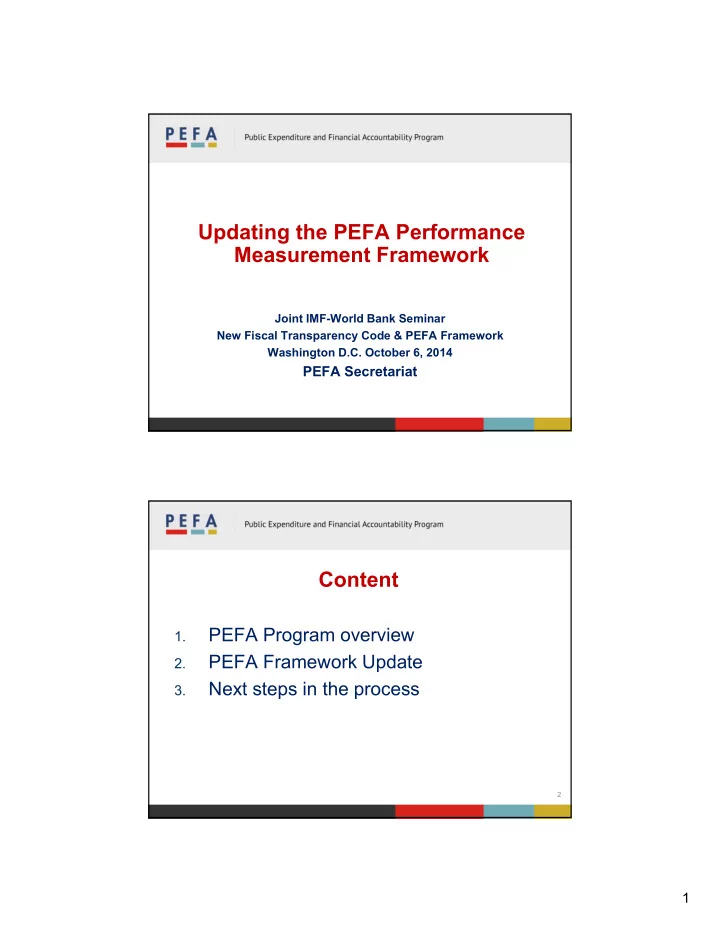

Updating the PEFA Performance Measurement Framework Joint IMF-World Bank Seminar New Fiscal Transparency Code & PEFA Framework Washington D.C. October 6, 2014 PEFA Secretariat Content PEFA Program overview 1. PEFA Framework Update 2. Next steps in the process 3. 2 1
1. PEFA PROGRAM OVERVIEW 3 The PEFA Program Aim: contribute to development effectiveness via the ‘Strengthened Approach’ to support PFM Reform ( country ‘Strengthened Approach’ to support PFM Reform ( country- led; harmonized PFM analytical work; common data pool ) The Performance Measurement Framework • the PEFA Framework ( Blue Book) ‘flagship’ of the PEFA Program launched by 7 Partners in June 2005 • Applicable to countries with different traditions, & at different stages of development 2
Purpose of the PEFA Framework It provides: High level overview of all aspects of a country’s PFM systems performance, including revenue, expenditure, procurement, financial assets/ liabilities It does not provide assessment of: It does not provide assessment of: underlying causes for good / poor performance government fiscal/expenditure policies 5 Components of the PEFA Framework • A standard set of high level PFM indicators A t d d t f hi h l l PFM i di t to assess performance against 6 core pillars of a PFM system • A concise, integrated performance report – the PFM-PR – developed to provide narrative on the indicators & draw a summary from the analysis 6 3
Structure of the PEFA Performance Measurement Framework D. Donor Practices C(1) (D-1-3) C. Budget Cycle Policy-based budgeting (PI-11-12) A. PFM Outturns C(2) C(4) B. Predictability Budget External Comprehensiveness and control Credibility scrutiny and Transparency in budget (PI-1-4) and audit ( PI-5-10) execution (PI-26-28) ( ) (PI 13 21) (PI-13-21) C(3) Accounting, Recording and Reporting (PI-22-25) 7 PEFA Scoring • Most indicators have 2, 3 or 4 dimensions • Each dimension must be rated separately • Calibrated on a four point ordinal scale (A, B, C, D) • Reflecting internationally accepted ‘good practice’ 8 4
The PEFA Framework – Objectives To assess the extent to which a country has the tools to deliver three main budgetary outcomes: • aggregate fiscal discipline • strategic resource allocation • efficient use of resources for service delivery Implement PFM reforms High level performance Formulate PFM overview reform program PEFA Assessment PEFA Assessment Countries can use PEFA to : Countries can use PEFA to : • Inform PFM reform formulation Identify main • Monitor reform efforts results Recommend PFM PFM progress, • Harmonize information needs reform measures strengthens weaknesses • Use PIs in monitoring system Investigate • Compare to & learn from peers underlying causes 9 5
2. PEFA FRAMEWORK UPDATE 11 Purpose of updating the Framework • Reflect evolution of ‘good practices’ • Improve areas of weakness and fill recognized gaps (e.g. public investment management) • Incorporate ‘clarifications’ Key principles: • Purpose remains the same • Universal applicability • Balance between comparability and relevance 12 6
Key principles (cont.) • Indicator ratings remain focused on “generally accepted good practice” = ‘A’ rating accepted good practice = A rating • “C” rating = basic level of functionality • Aim for similar number of indicators or less but possible to add dimensions to the existing indicators (e.g. monitoring of existing indicators (e.g. monitoring of contingent liabilities) • Proposals must be subject to testing 13 Update process - progress to date 2012 • Open “pre-consultation” stage - what needs to be updated • Baseline technical workshop – on how to improve the Framework 2013 • Review issues identified by assessors in the field (e.g. clarity, calibration, multiple criteria) • Research of “thematic/environmental” issues (natural resource revenue, transparency/accountability, investment management) • 4 teams of technical experts worked under the Steering C Committee supervision itt i i 2014 • Initial testing at country level began April 2014 – preliminary draft indicators tested in coordination with ongoing PEFA assessments • Draft of the Updated PEFA Indicator set released for public consultation August 7 – deadline for feedback by October 31 14 7
Update Indicators - major proposals Introduce three new indicators to address issues not covered in the existing Framework: (i) “Credible Fiscal Strategy”, (ii) “Public Investment Management”, (iii) “Public Asset Management” Reformulate revenue indicators (PI-13, 14, 15) to broaden coverage beyond taxation (tax & non taxes revenues) Incorporate performance information in PI-23 on service delivery Strengthen focus on transparency, liability management & fiscal risks (contingent liabilities, guarantees, PPPs) and Internal Control Remove Donor indicators – donor funded revenue & expenditure incorporated into other indicators 15 New Indicators Credible Fiscal Strategy (CFS): Setting fiscal objectives/targets Setting fiscal objectives/targets i i. Preparing macroeconomic forecasts ii. Forecast & outturn of CG fiscal balance (GFS) iii. • Public Investment Management Project appraisal/selection i. Project budgeting ii. Project monitoring and reporting Project monitoring and reporting iii iii. • Public asset management Financial asset monitoring i. Non-financial asset monitoring ii. Transparency in the sale of non-financial assets iii. 16 8
Indicators reformulated Revenue Indicators : expanded to include non-tax revenues (including natural resources) PI-13 focuses on forecasting PI-14 focuses on administration & compliance PI-15 focuses on accounting • PI-20 – Internal control : stronger focus on a wide range of internal controls (segregation of duties, commitment controls, compliance with payment controls) • PI-23 - Service delivery : incorporates performance information on service delivery (disclosure of annual targets and results) 17 3. NEXT STEPS IN THE PROCESS 18 9
Next steps • Update of the PFM Performance Report format/content • Testing continuing to aide finalization of the updated methodology g g p gy • Further adjustments based on feedback from stakeholders and tests • “New release” – 2015 Transitional arrangements • All assessments to use updated Framework after publication • Issue of detailed guidance (incl. data requirements, bridge table, comparability and tracking of change in repeat assessments) comparability and tracking of change in repeat assessments) • Announcement of cut-off date for use of the existing Framework 19 Thank you for your attention 20 10
Recommend
More recommend